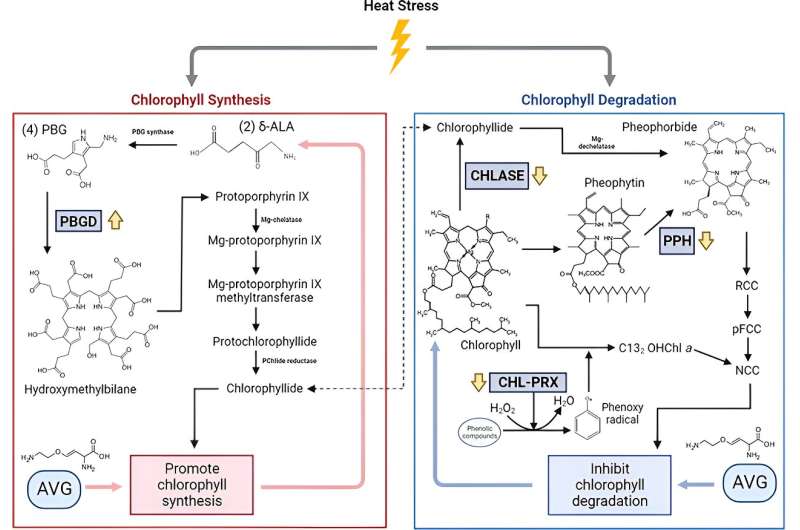This article has been reviewed according to Science X's editorial process and policies. Editors have highlighted the following attributes while ensuring the content's credibility:
fact-checked
peer-reviewed publication
trusted source
proofread
Apple preharvest drop not linked to xylem functionality

Heat stress induces and accelerates leaf senescence, which is characterized by a loss of chlorophyll and cellular membrane deterioration, as well as oxidative damage). Leaf senescence can be exacerbated by the hormone ethylene, which acts as a signal to trigger cellular maturation and senescence.
Ethylene is produced at higher rates in plants exposed to heat stress, which induces premature leaf senescence. Inhibition of ethylene synthesis or action has been found to be effective for suppressing leaf senescence in different plant species subjected to abiotic stresses, including heat stress; therefore, the application of ethylene inhibitors is a viable approach to prolonging leaf growth to improve plant stress tolerance.
The objective of this study was to determine whether foliar-spraying the ethylene inhibitor, aminoethoxyvinylglycine (AVG), may suppress heat-induced leaf senescence through effects on chlorophyll synthesis and degrading enzymes in creeping bentgrass (Agrostis stolonifera).
Plants were maintained in environmentally controlled growth chambers under non-stress (22/17 °C day/night) or heat stress (35/30 °C day/night) temperature conditions for 25 days, and turf quality, electrolyte leakage, and chlorophyll content were measured to assess the extent of leaf senescence.
Plants were foliar-sprayed with 25 µm AVG before and during heat stress at 7-day intervals. From 21 through 25 days of heat stress, AVG-treated plants had significantly higher turf quality and chlorophyll content, whereas electrolyte leakage was significantly lower in comparison with untreated controls
The findings of the current study in tandem with previous studies suggest that AVG could suppress heat-induced leaf senescence by maintaining chlorophyll synthesis and alleviate chlorophyll degradation in creeping bentgrass exposed to heat stress through action on enzymatic activities, in addition to the other mechanisms previously reported.
Understanding how AVG may regulate chlorophyll metabolism at the molecular level may facilitate the development of novel lines of cool-season grass species with stay-green traits to maintain high-quality turfgrass during summer months.
The paper is published in the Journal of the American Society for Horticultural Science.
More information: Stephanie Rossi et al, Heat-induced Leaf Senescence in Creeping Bentgrass Suppressed by Aminoethoxyvinylglycine Involving Regulation of Chlorophyll Metabolism, Journal of the American Society for Horticultural Science (2023). DOI: 10.21273/JASHS05297-23
Journal information: Journal of the American Society for Horticultural Science
Provided by American Society for Horticultural Science




















